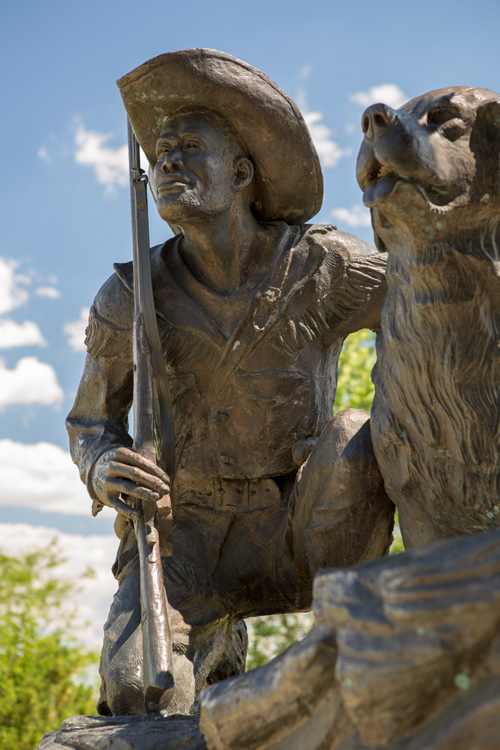After nearly one and half months divided into as many as five separate detachments, all the members of the Corps of Discovery were finally reunited at noon on the twelfth of August at Reunion Bay, 142 miles downriver from the mouth of the Yellowstone.
Splitting Forces at Travelers’ Rest
York and Seaman
Great Falls Tourist Center
© 2015 by Kristopher K. Townsend. Permission to use granted under the Creative Commons Attribution-Share Alike 4.0 International license.
At Travelers’ Rest on the morning of 3 July 1806, the captains had split the Corps of Discovery in two. Clark led his 20-man contingent back to Fortunate Camp on the Beaverhead, with Sgt. Pryor and six men herding their 50 horses, while the captain accompanied the six canoes as far as the Three Forks of the Missouri. From there, Sgt. Ordway and nine other soldiers paddled the canoes down to White Bear Islands, while Clark and the remaining ten men mounted the horses and rode up the Gallatin River, through Bozeman Pass to the Yellowstone River at the big bend, and proceed downriver until they found large enough trees to make canoes. Thereupon, Sgt. Pryor and three helpers left to drive the horses on ahead to the Knife River villages.
Lewis, meanwhile, followed the Blackfoot River back to White Bear Islands above the Falls, and leave with three others to explore the upper Marias River leaving the rest to await Ordway’s arrival with the canoes. Sergeants Ordway and Gass supervised the portage of the canoes back around the Falls with plans to pick up Lewis and his detail at the mouth of the Marias. The whole party, except for Sgt. Pryor and his helpers, were to rendezvous at the mouth of the Yellowstone about the first of August.
Sgt. Pryor Returns
When Pryor finally caught up with Clark’s party, Clark was scarcely able to hide his despair over the loss of all of their horses. The Corps of Discovery was bankrupt. The Indians had stolen his credit card. For one thing, their diet of fresh meat was nutritionally inadequate, and Clark had counted on using some of those horses to solve that problem when they reached the Mandan villages. Though none of the Corps would have been able to explain what was ailing them, their bodies were aching for the vitamins (A and C) and minerals (especially calcium and iron) in vegetables. Clark therefore gave the hunters an urgent assignment. “My object is to precure as many Skins as possible for the purpose of purchaseing Corn and Beans of the Mandans,” he groaned. “As we have now no article of Merchindize nor horses to purchase with, our only resort is Skins which those people were very fond the winter we were Stationed near them.”
Worse yet, on 11 August 1806 Clark met “two men from the illinoies,” traders Joseph Dixon and Forrest Hancock, who told him the middle Missouri was aflame with warfare—Mandans, Hidatsas, Arikaras, Assiniboines, Lakota Sioux, Blackfeet—and both British and American traders were being threatened, robbed, wounded, even killed. Forget about Heney and the bold diplomatic plan. They would be lucky to get through the field of combat with their lives.
Lewis Pursues Clark
On 12 August 1806, Lewis, still in pain from the wound Pierre Cruzatte‘s misdirected rifle ball had made in his derriere on the previous day, suffered further from the news of Pryor’s misfortune, which he read in the note Clark had left at his campsite of the previous day. “This I fear, puts an end to our prospects of obtaining the Sioux Cheifs to accompany us,” he lamented. There wasn’t enough time left in the season to connect with Heney, much less for Heney to negotiate arrangements with the Lakota Sioux for one or more of their headmen to consider traveling to that unknown land where the “great white chief” dwelled. The only recourse was to initiate a new and simpler plan: take back any Indian chief they could persuade to go.
The Final Reunion
All the members of the Corps of Discovery were finally reunited at noon on the twelfth near Shell Creek, 142 miles downriver from the mouth of the Yellowstone, when Lewis and his contingent “hove in Sight with the party which went by way of the Missouri.” Sergeant Gass appended the benediction, as if to himself: “(thanks to God).”
Soon, they were back among the Mandans and Hidatsas on 14 August 1806, where Posecopsahe (Black Cat), Sheheke (Big White), and several other chiefs tried to outdo one another in expressing their hospitality with gifts of corn—more, finally, than the Corps could carry away. The captains were dismayed, however, to learn that the peace Sheheke had brokered with the Arikaras had reverted to warfare, and that the Sioux were still in command of the lower Missouri.
Experience the Lewis and Clark Trail
The Lewis and Clark Trail Experience—our sister site at lewisandclark.travel—connects the world to people and places on the Lewis and Clark Trail.
Discover More
- The Lewis and Clark Expedition: Day by Day by Gary E. Moulton (University of Nebraska Press, 2018). The story in prose, 14 May 1804–23 September 1806.
- The Lewis and Clark Journals: An American Epic of Discovery (abridged) by Gary E. Moulton (University of Nebraska Press, 2003). Selected journal excerpts, 14 May 1804–23 September 1806.
- The Lewis and Clark Journals. by Gary E. Moulton (University of Nebraska Press, 1983–2001). The complete story in 13 volumes.


